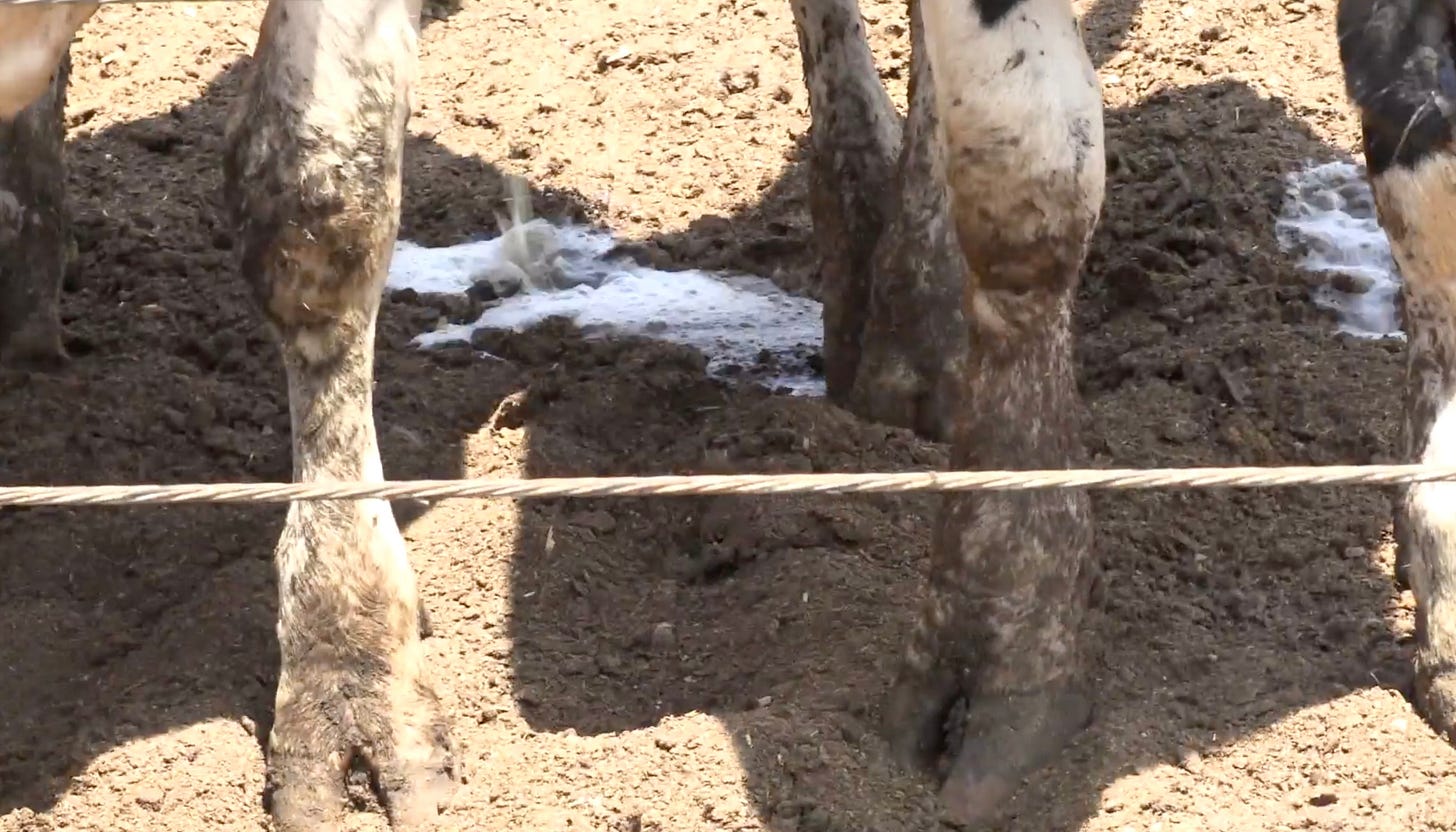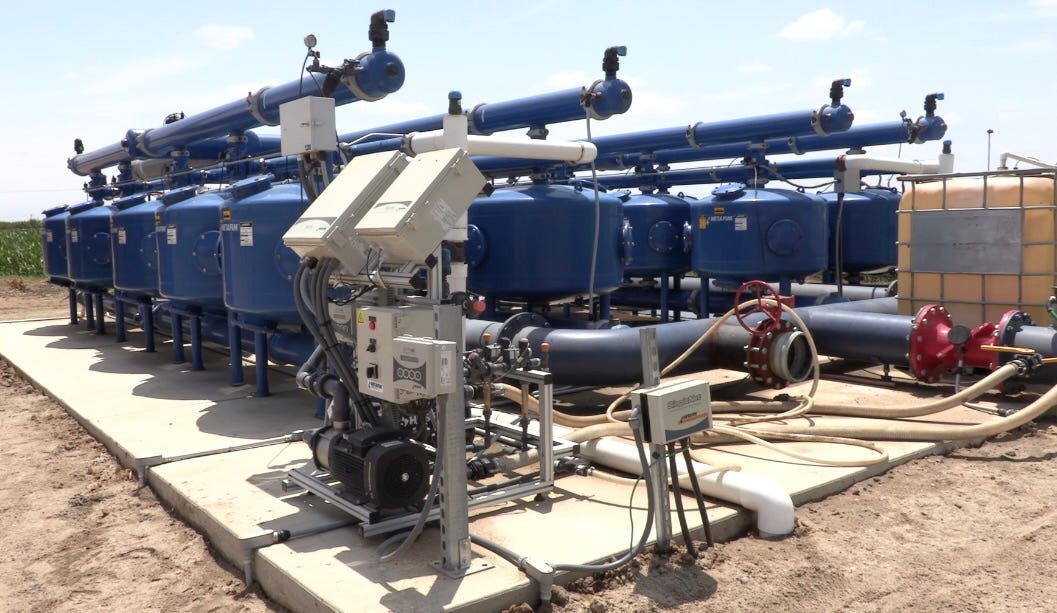My nose for offbeat news has taken me to a corn field in the middle of California’s Central Valley, where something’s missing — I’m not smelling the back side of a cow.
Usually you can’t escape the aroma of bovine urine and feces as you drive along Interstate 5 or State Route 99, traversing America’s most productive farmland, where crops grow and cows crap. This valley is America’s breadbasket and the nation’s top dairy region.
But as I stand 100 yards away from a cow barn outside the town of Chowchilla, this cornfield smells like… a cornfield… even though the irrigation water includes cow urine.
How can that be?
Facts first.
Piss Poor Environmental Footprint
California’s 1.7 million “happy cows” create a lot of manure and urine runoff. According to the USDA, that effluent contains nitrogen, shooting gases into the atmosphere, especially ammonia.
“Greenhouse gas emissions, fossil energy use and blue water use associated with dairy production were found to be relatively small compared to total estimates for the nation,” the USDA stated in a 2020 report about the entire U.S. dairy industry. However, when it came to ammonia, “dairy farms may emit as much as 24% of the estimated emission for the whole country.”
Solid manure (poop) at dairy operations is often turned into fertilizer. Some farms are using equipment to capture methane coming off that manure and piping it to power plants.
But urine, or “liquid manure,” is handled differently. It’s flushed into pits where it’s sometimes diluted with regular water and put directly on crops for irrigation.
It smells terrible.
Water is water, though, and urine helps offset the cost of fresh water, which skyrocketed during the latest California drought. An index that tracks the general price saw water go from $216 an acre in September 2019 to nearly $1,300 last summer, a sixfold increase. It’s now back down to $313, thanks to this year’s massive rains, but farmers expect more dry years than wet.
A “Solution” Solution
Richie Mayo is CFO at DeJager Farms, overseeing 18,000 acres of crops like corn and alfalfa that feed cows at DeJager’s massive dairy operation. “It’s difficult, the margins are relatively low,” he says.
Richie and his colleagues decided there had to be a better way to use the urine runoff from their cows. In 2014, they connected with Netafim, an Israeli-based drip irrigation company. Together with a non-profit called Sustainable Conservation, they began testing a “subsurface drip irrigation (SDI) technology” which takes cow urine and turns it into underground drip irrigation water, then uses it to grow corn for cows to eat. It’s the perfect closed loop: Cows to urine to water to food to cows.
“When you work with cows and live animals, [the urine] is not ever standard,” explains Domonic Rossini, who manages farm relationships for Netafim in the Western United States.
Domonic says it took a while for Netafim to find the right self-flushing filters and valves. “We tried some ‘mixing mounts’ that were $30,000 that blew apart after a couple of months,” he says.
After working out the kinks, DeJager experimented with the system on an 80-acre plot, irrigating 40 acres the traditional way (flooding) and 40 acres with the Netafim system.
The system works like this: Urine from dairy cows goes through a filter to take out any solids. Then the effluent is put through a computerized system to test nitrogen levels (the more salt in the urine, the more nitrogen). Based on those numbers, along with the needs of the corn that day, the system mixes in the right ratio of fresh water to urine, and the blended product is piped into irrigation lines buried a foot beneath the surface of the cornfield.
“We probably average 30% liquid manure to 70% freshwater,” Richie tells me.
Less Water, Higher Yields
The results have been impressive. Richie says his water usage dropped 35% while corn yields soared 30%. DeJager has since expanded the system from 40 acres to 1,000. What’s more, he says, the water has so many nutrients, “I haven’t applied any synthetic nitrogen this season.” That’s a savings of over $200 an acre.
Plus, there’s no smell! That’s because the drip line is buried (which also reduces the release of ammonia into the atmosphere).
Netafim now has 29 farms either using the system or signed up for it. Domonic claims it can save farmers nearly 330,000 gallons of water per acre per season. Perhaps even more surprising, “The plants are healthier.”
It’s Not Cheap, but There’s “A Four-year Payback”
You know I’m all about the money.
Richie says the system cost $3,700 to $4,000+ an acre to install. But, this being agriculture, well… there’s help. A federal (cough *taxpayer*) grant program to California is currently covering about two-thirds of the price. The farmer covers the rest. How long to recoup that investment? “It has about a four-year payback,” Richie tells me.
Dairy farmers have been under pressure to be more sustainable. Some of their customers, from Starbucks to Walmart, want them to get to a “net zero” carbon footprint. Reducing water usage and ammonia emissions by injecting liquid manure into an underground irrigation system may help achieve green goals better than buying carbon offsets (don’t get me started on carbon offsets).
But Richie cautions the system isn’t for every farm or every crop. For example, it’s not ideal for growing alfalfa, which doesn’t need a lot of nitrogen. It’s also not yet approved for crops eaten by humans, like tomatoes.
One other reason he’s only using the system on a portion of the farm is because he still sees the benefits of watering the traditional way in the Central Valley — flood irrigation. It may sound inefficient, but with the abundance of rain this year, farmers were being asked by authorities to flood their fields to help contain runoff. “We were able to recharge the aquifer faster and more efficiently than anybody else, because we still have our old-school systems,” Richie explains. “A lot of these people who’ve gone strictly to drip were unable to do that as effectively.”
What About the Corn Belt?
Netafim is now testing the system in other countries, like Italy, but its biggest challenge is selling the idea to farmers in the Midwest. That would be a huge market, but drip irrigation isn’t common in the Corn Belt. So this year the company will begin working with a hog farmer in the Midwest who also grows corn and soybeans.
“There are so many acres that now get either a dragline application (of water) or a tanker application with a very limited window in the fall and in the spring,” says Jim Ed Beach (best farmer name ever). He heads up commercial sustainable solutions for Netafim USA. “There’s never really been a way to apply nitrogen in-season during the crop growth stages,” Jim Ed tells me, “and this system will give you the opportunity to apply nitrogen throughout the season.”
Other Crops, Other Water
Netafim hopes to get government approval to use the system on tomatoes, almonds, and other crops that humans eat. Domonic Rossini says his company’s system is superior to many practices currently used in organic farming. “You have chicken feet and fish heads,” he tells me. “This would actually be more sanitary than those processes, because you're going to be putting it in through the drip, and it'd be done subsurface.”
The company also believes the system can treat more than cow urine. Jim Ed Beach says industrial water from vineyards or vegetable processors would work, too. “You might have a packing shed that has a wash plant,” he says. “Why not utilize that water for irrigation instead of having to send it through a big treatment process before you release it back into a stream or river?”
“This technology is driven by water costs and water scarcity,” Richie Mayo says. He believe other farmers will make the necessary investments if the technology makes sense, and cents. “As farmers, we follow profitability.”
And nothing’s more sustainable than that.










wow! that's an incredible development! which begs the question of when will they take even a portion of the poop to make a "smoothie" that can be distributed thru farm plumbing to the various crops? likewise the chicken feet or fish heads could go thru (their own) blender for another smoothie nutrient?
You get the most interesting topics! Cow urine?!